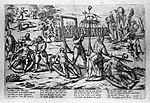File:Peter Stump execution.jpg
Appearance

Size of this preview: 590 × 599 pixels. Other resolutions: 236 × 240 pixels | 473 × 480 pixels | 761 × 773 pixels.
Original file (761 × 773 pixels, file size: 363 KB, MIME type: image/jpeg)
File history
Click on a date/time to view the file as it appeared at that time.
| Date/Time | Thumbnail | Dimensions | User | Comment | |
|---|---|---|---|---|---|
| current | 00:33, 18 July 2020 |  | 761 × 773 (363 KB) | Beyond My Ken | =={{int:filedesc}}== {{Information |description={{en|1=This wood cut shows the 'breaking wheel' as it was used in Germany in the Middle Ages. The exact date is unknown, as is the creator, but it depicts the execution of {{w|Peter Stumpp}} in Cologne in 1589. This form of punishment was most common during the middle ages and early modern age. Though, for example in many regions of future Germany, the breaking wheel was still used in the 19th century. The last known execution happened 1841... |
File usage
The following page uses this file:
Global file usage
The following other wikis use this file:
- Usage on hu.wikipedia.org


